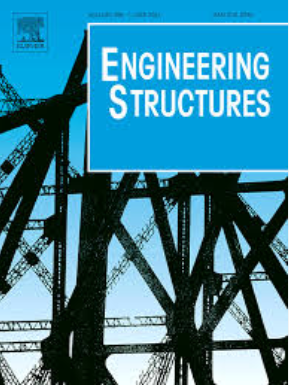考虑多重损伤裂缝的腐蚀RC梁火灾下动、静力特性三维精确数值计算方法
IF 6.4
1区 工程技术
Q1 ENGINEERING, CIVIL
引用次数: 0
摘要
本文提出了一种精确的三维数值模拟方法来分析腐蚀钢筋混凝土(RC)梁在火灾下的性能。考虑了多种损伤因素,包括腐蚀开裂、荷载引起的开裂和混凝土覆盖层的剥落。具体而言,采用内聚单元、混凝土损伤塑性模型和生灭单元分别有效模拟腐蚀RC梁的腐蚀开裂、荷载诱发开裂和覆盖层剥落。将这些损伤机制纳入传热模型中,以获得准确的温度场。随后,在静态加载模型中引入了预先设定的温度场。此外,模型中还使用了三维弹簧来表示钢筋与混凝土之间的腐蚀粘结退化。随后,通过温度场和静载结果分析,系统研究了火灾暴露时间、腐蚀程度和覆盖层厚度对腐蚀RC梁热静态性能的影响。通过数值模拟对腐蚀RC梁进行了模态分析。结果表明,腐蚀RC梁火灾后的一阶固有频率变化与剩余弯矩承载力密切相关。基于这种相关性,提出了一种新的基于动力分析的剩余弯矩容量预测方程。与实验值相比,它具有较高的精度,误差在10 %以内。综上所述,本研究提供了一种基于结构振动固有频率预测腐蚀RC梁火灾后剩余弯矩容量的方法,而不会对结构造成任何损害。本文章由计算机程序翻译,如有差异,请以英文原文为准。
A precise 3D numerical method of dynamic and static behaviors in corroded RC beams exposed to fire: Considering multi-damaged cracks
This paper presents a precise 3D numerical simulation method for analyzing the behavior of corroded reinforced concrete (RC) beams exposed to fire. Multiple damage factors, including corrosion cracking, load-induced cracking, and spalling of the concrete cover were considered. Specifically, cohesive elements, the concrete damaged plasticity model, and birth-death elements are employed to effectively simulate corrosion cracking, load-induced cracking, and cover layer spalling in corroded RC beams, respectively. These damage mechanisms are incorporated into the heat transfer model to obtain accurate temperature field. Subsequently, the temperature severed as the predefined filed was introduced into the static loading model. Moreover, 3D springs were also employed into the model to represent the corrosion-induced bonding degradation between reinforcement and concrete. Following this, the effects of fire exposure time, corrosion level, and cover layer thickness on the thermal and static behavior of corroded RC beams was systematically investigated through analysis of temperature field and static loading results. Furthermore, modal analysis was conducted on corroded RC beams through numerical simulation. It was observed that the first-order natural frequency variation of corroded RC beams after fire exposure correlates closely with residual moment capacity. Based on this correlation, a novel prediction equation derived from dynamic analysis was proposed to evaluate residual moment capacity. It demonstrates a high-level accuracy within 10 % error compared to experimental values. In conclusion, this study provides a method for predicting the residual moment capacity of corroded RC beams after fire exposure based on the structure's vibrational natural frequency, without causing any damage to the structure.
求助全文
通过发布文献求助,成功后即可免费获取论文全文。
去求助
来源期刊

Engineering Structures
工程技术-工程:土木
CiteScore
10.20
自引率
14.50%
发文量
1385
审稿时长
67 days
期刊介绍:
Engineering Structures provides a forum for a broad blend of scientific and technical papers to reflect the evolving needs of the structural engineering and structural mechanics communities. Particularly welcome are contributions dealing with applications of structural engineering and mechanics principles in all areas of technology. The journal aspires to a broad and integrated coverage of the effects of dynamic loadings and of the modelling techniques whereby the structural response to these loadings may be computed.
The scope of Engineering Structures encompasses, but is not restricted to, the following areas: infrastructure engineering; earthquake engineering; structure-fluid-soil interaction; wind engineering; fire engineering; blast engineering; structural reliability/stability; life assessment/integrity; structural health monitoring; multi-hazard engineering; structural dynamics; optimization; expert systems; experimental modelling; performance-based design; multiscale analysis; value engineering.
Topics of interest include: tall buildings; innovative structures; environmentally responsive structures; bridges; stadiums; commercial and public buildings; transmission towers; television and telecommunication masts; foldable structures; cooling towers; plates and shells; suspension structures; protective structures; smart structures; nuclear reactors; dams; pressure vessels; pipelines; tunnels.
Engineering Structures also publishes review articles, short communications and discussions, book reviews, and a diary on international events related to any aspect of structural engineering.
 求助内容:
求助内容: 应助结果提醒方式:
应助结果提醒方式:


